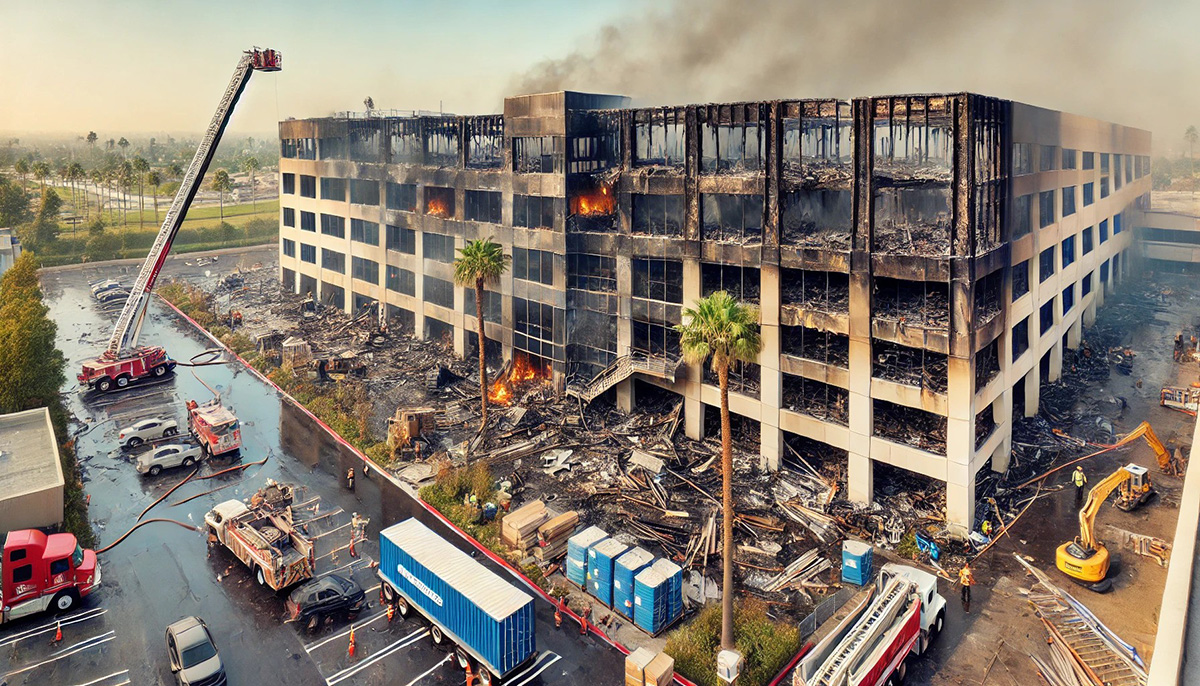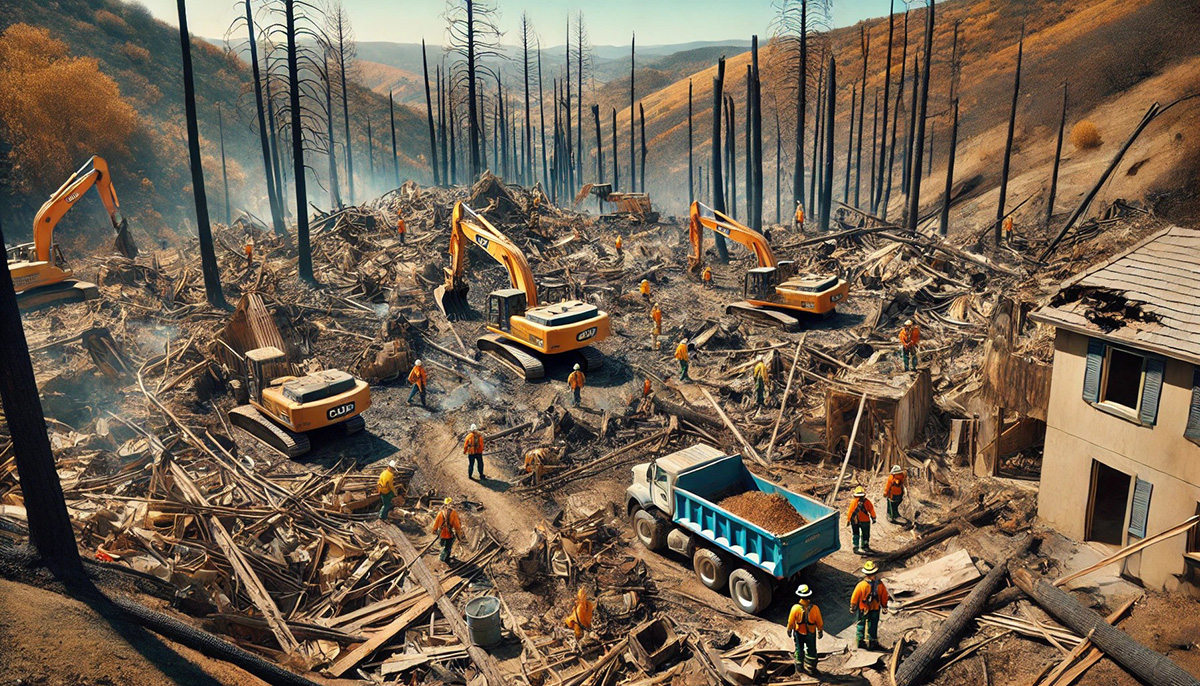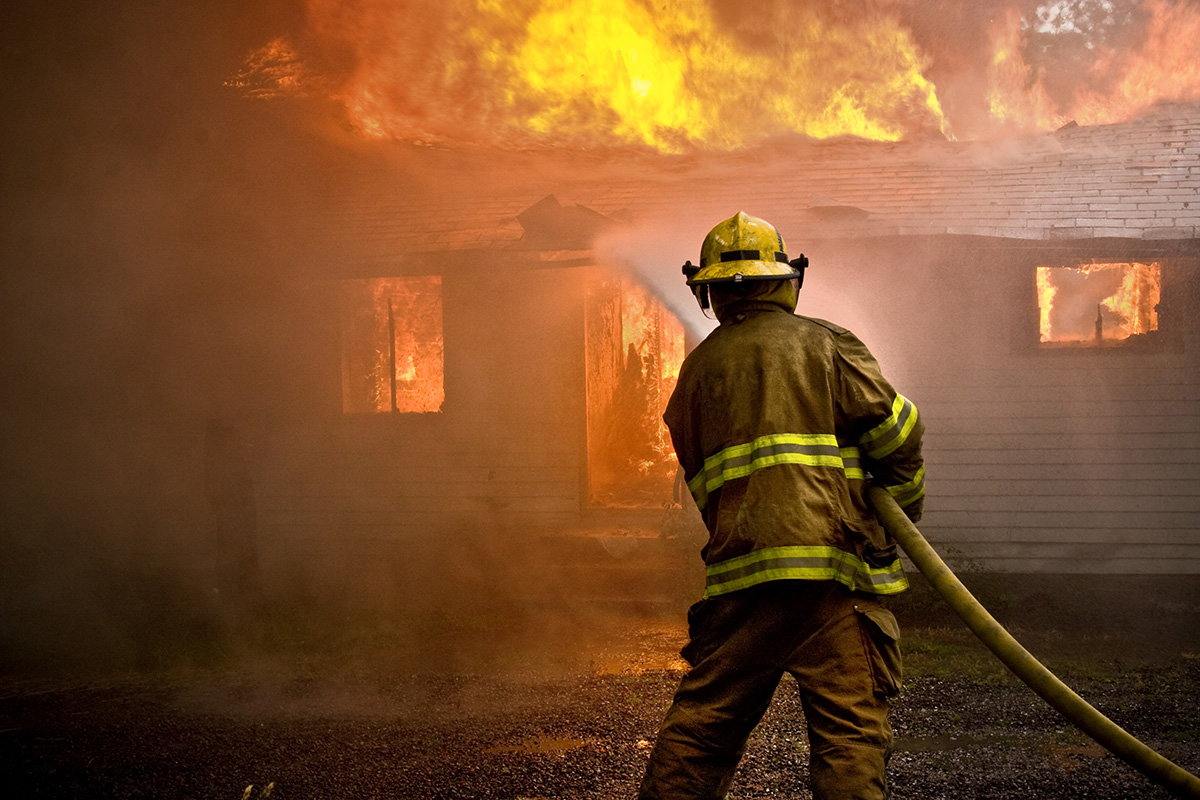Wildfires in California are more than just a seasonal threat—they are a year-round risk that can cause billions of dollars in damage to homes, businesses, and infrastructure. In 2023 alone, California wildfires burned over 332,822 acres, forcing thousands of residents and business owners to navigate the complex process of fire damage recovery and prevention.
If you own a commercial or residential property, understanding the necessary steps for fire damage restoration and wildfire preparedness is critical. Failing to act swiftly after a fire can lead to secondary damage, increased repair costs, and potential compliance issues with California fire safety regulations.
This guide provides a step-by-step breakdown of how to recover from wildfire damage, including:
- How to assess fire damage effectively
- Best practices for restoring commercial and residential buildings
- Filing insurance claims for wildfire-related losses
- Fire-resistant building materials and design strategies
- Creating defensible space and wildfire prevention landscaping
- Understanding California’s fire safety building codes
By following these expert insights, property owners in California can rebuild stronger, safer, and better prepared for future wildfires.
Take Action Now! Don’t wait until it’s too late—protect your home or business from wildfire damage today. Whether you need expert restoration services or want to enhance your fire prevention measures, Nationwide Fire Protection is here to help. Call us now at (310) 750 9999 for a free consultation and safeguard your property against future wildfires!
California Wildfire Recovery: Initial Damage Assessment
Fire Damage Assessment Procedures
Before beginning any restoration efforts, property owners must conduct a thorough fire damage assessment to determine the extent of destruction. Professional fire damage inspectors and restoration experts use standardized procedures to evaluate:
- Charring and structural damage – Walls, beams, and foundations are inspected for fire-induced weaknesses.
- Water damage from firefighting efforts – Excess moisture from fire suppression systems and fire hoses can lead to mold growth and further deterioration.
- Debris patterns and hazardous materials – Specialists identify any remaining toxic residue, soot, and ash, ensuring a safe cleanup process.
It’s crucial to document all damage with photographs and videos before beginning any restoration work. This visual evidence will play a key role in securing insurance claims and ensuring compliance with California fire recovery guidelines.
Assessing Structural Integrity in Commercial Buildings
For commercial buildings, post-fire assessments are even more critical, as structural weaknesses can pose severe safety hazards to employees and customers. Licensed structural engineers and fire restoration specialists use advanced tools, such as:
- Thermal imaging cameras to detect hidden damage
- Moisture meters to assess water exposure
- Load-bearing tests to evaluate compromised structural elements
If a commercial building is deemed unsafe, immediate steps should be taken to secure the property, including:
- Installing temporary reinforcements to stabilize weakened structures
- Conducting air quality tests to check for hazardous smoke particles
- Developing a phased restoration plan that aligns with local fire safety codes
A well-structured damage assessment not only ensures a safe recovery but also reduces downtime for businesses, allowing for a faster return to normal operations.
Residential Fire Damage Cleanup & Restoration
Residential Fire Damage Restoration Services in California
After a wildfire, homeowners must act quickly to mitigate further damage and begin the restoration process. Residential fire damage restoration services in California follow strict industry standards to ensure homes are structurally sound, free of hazardous contaminants, and livable once again.
Key components of a successful fire damage restoration plan include:
- Soot and Smoke Removal – Wildfires leave behind hazardous soot and smoke residue, which can cause respiratory issues and long-term property damage. Restoration experts use industrial-grade HEPA vacuums, air scrubbers, and chemical sponges to eliminate toxic particles.
- Water Extraction and Mold Prevention – Firefighting efforts often leave homes with significant water damage, leading to mold growth if not properly dried. Dehumidifiers and moisture meters are used to restore indoor air quality.
- Structural Repairs and Reconstruction – Damaged walls, flooring, and roofing require immediate repair to ensure the home’s safety and stability. Some structures may need complete rebuilding to meet California’s fire-resistant construction standards.
- Odor Elimination – Smoke damage can linger in carpets, walls, and air ducts. Advanced odor-removal techniques, such as ozone treatments and thermal fogging, help restore indoor air quality.
Pro Tip: The sooner fire damage restoration begins, the better the chances of salvaging belongings and reducing repair costs. Homeowners should contact licensed fire restoration specialists immediately to prevent secondary damage.
Commercial Building Fire Damage Repair & Rebuilding

Steps for Commercial Building Owners to Recover from Wildfire Damage
Unlike residential properties, commercial buildings often face more complex fire damage restoration challenges, including code compliance, large-scale infrastructure repairs, and business continuity concerns. The first 48 hours after a wildfire are critical for limiting long-term damage.
Key steps for commercial building recovery:
- Conduct an Immediate Safety Inspection – Work with fire restoration experts and local authorities to ensure the property is safe for entry.
- Secure the Building – Install temporary fencing, boarding up windows, and reinforcing structural weaknesses to prevent further damage or vandalism.
- Remove Fire Debris and Hazardous Materials – Fire-damaged materials, toxic ash, and unstable structures must be professionally removed and disposed of.
- Restore Electrical, HVAC, and Plumbing Systems – Fire can compromise electrical wiring, HVAC units, and plumbing. Licensed contractors should assess these systems before reopening the building.
- Develop a Fire-Resistant Rebuilding Plan – Use fireproof materials, defensible landscaping, and upgraded fire suppression systems to prevent future disasters.
Best Practices for Rebuilding After California Wildfires
For both commercial and residential properties, rebuilding after wildfire damage requires careful planning, budgeting, and compliance with California fire codes.
- Use Fire-Resistant Building Materials – Incorporate fiber cement siding, fire-rated windows, and metal roofing to minimize future fire risks.
- Implement Defensible Space Landscaping – Maintain at least a 100-foot clearance zone around buildings, removing flammable vegetation and using fire-resistant plants.
- Upgrade Fire Suppression Systems – Ensure your property has automatic sprinklers, fire alarms, and smoke detection systems that comply with NFPA and California fire safety standards.
- Consider Solar Panels with Battery Backup – Power outages are common after wildfires. A solar-powered backup system can help maintain critical functions during recovery.
By incorporating fire-resistant design elements and modern fire safety measures, property owners can reduce future wildfire risks and improve overall resilience.
Insurance Claims for Wildfire Damage
How to File Insurance Claims After California Wildfires
Filing an insurance claim after wildfire damage can be overwhelming, but taking the right steps early on can help maximize your payout and speed up the recovery process. California property owners should follow a structured approach to ensure a smooth and successful claims process.
Step-by-Step Guide to Filing a Wildfire Damage Claim:
- Document the Damage Immediately
- Take high-quality photos and videos of all fire-damaged areas, including interior and exterior structures, furniture, personal belongings, and equipment.
- Create a detailed inventory of damaged or lost items, including their approximate value, purchase date, and receipts (if available).
- Review Your Insurance Policy
- Check your coverage limits, deductibles, and exclusions to understand what is covered.
- Identify if your policy includes Additional Living Expenses (ALE), which helps cover temporary housing and other expenses if your home is uninhabitable.
- Notify Your Insurance Provider Immediately
- Contact your insurer as soon as possible to file a formal claim.
- Provide preliminary damage details and request a claims adjuster to assess the property.
- Schedule an Inspection with the Insurance Adjuster
- Ensure that an insurance adjuster visits your property to evaluate damages.
- If possible, hire an independent adjuster to provide an unbiased second opinion.
- Keep Track of All Communications and Expenses
- Maintain a claim log that includes all emails, calls, and letters with your insurer.
- Save receipts for temporary repairs, accommodations, and other wildfire-related expenses to request reimbursement.
- Negotiate If Necessary
- Insurers may offer lower initial settlements than expected. Do not accept the first offer without review.
- If needed, consult a public adjuster or attorney to help you get fair compensation.
By following these steps, property owners can ensure timely reimbursement for fire damage restoration and rebuilding costs.
Fire-Resistant Building Materials & Design
Recommended Fire-Resistant Building Materials for California Homes
One of the most effective ways to reduce wildfire risk is by using fire-resistant construction materials. California’s fire safety building codes require new homes and commercial properties in wildfire-prone areas to incorporate non-combustible and fire-resistant materials.
Best Fire-Resistant Materials for Homes & Businesses:
- Fire-Rated Roofing: Metal, clay, concrete, or Class A asphalt shingles
- Exterior Siding: Fiber cement, stucco, and non-combustible composite materials
- Windows & Doors: Tempered glass, fire-rated steel doors, and ember-resistant vents
- Decking & Fencing: Fire-resistant composite decking or Class A-rated wood alternatives
- Insulation: Mineral wool, fire-rated gypsum board, and non-combustible insulation materials
Bonus Tip: When rebuilding after a wildfire, consider reinforced concrete foundations and fireproof exterior coatings for additional protection.
Choosing Fire-Resistant Roofing and Home Design Solutions
Roofing is one of the most vulnerable areas during a wildfire. Embers can land on the roof and ignite flames, leading to rapid structural loss.
Fire-Resistant Roofing Solutions:
- Metal Roofing: Non-combustible and highly resistant to flying embers
- Clay & Concrete Tiles: Offer natural fire resistance and durability
- Class A Asphalt Shingles: Specially treated to resist fire damage
- Green Roof Systems: Live vegetation layers that provide natural insulation and ember resistance
Fire-Safe Home Design Features:
- Sealed Eaves & Overhangs: Prevent embers from entering gaps under the roof
- Automatic Fire Sprinklers: Detect heat and extinguish flames before spreading
- Ember-Resistant Vents: Block small embers from entering attics and crawl spaces
Integrating fire-resistant materials and proactive home design strategies can significantly reduce wildfire risks and increase your home’s resilience.
Creating Defensible Space and Fire Prevention Landscaping
Defensible Space Guidelines in California
Creating a defensible space is one of the most effective ways to protect homes and commercial properties from wildfires. California law requires property owners in high-risk wildfire areas to maintain a 100-foot defensible space zone around their buildings. This buffer helps slow down or stop the spread of fire before it reaches a structure.
Defensible Space Zones in California:
- Zone 1: Immediate Zone (0-5 feet from the structure)
- Remove all dead plants, leaves, and debris from roofs, gutters, decks, and patios.
- Replace wood mulch with gravel or non-flammable ground cover.
- Use fire-resistant plants and avoid flammable materials like wood fences.
- Zone 2: Intermediate Zone (5-30 feet from the structure)
- Trim tree branches at least 10 feet away from chimneys and roofs.
- Space shrubs and trees properly to prevent flames from spreading.
- Keep grass cut to a maximum of 4 inches high.
- Zone 3: Extended Zone (30-100 feet from the structure)
- Create a fuel break by thinning trees and removing dense vegetation.
- Stack firewood at least 30 feet away from the house.
- Maintain at least 10 feet between tree canopies to prevent wildfire spread.
By properly managing defensible space, property owners increase their chances of surviving a wildfire and reduce the risk of severe fire damage.
Post-Wildfire Debris Removal & Property Maintenance

Importance of Regular Maintenance to Prevent Fire Hazards
Fire prevention doesn’t end with recovery—ongoing maintenance is essential to keep properties protected from future wildfires. Regular inspections, cleaning, and upgrades help eliminate fire risks and ensure buildings remain compliant with California’s strict fire safety codes.
Key Fire Prevention Maintenance Tasks:
- Roof & Gutter Cleaning: Remove leaves, pine needles, and other debris that could catch fire.
- HVAC & Vent Maintenance: Ensure ventilation systems are clear of flammable particles and install ember-resistant vents.
- Fire Sprinkler System Inspections: Schedule annual fire suppression system checks to confirm proper function.
- Property Clean-Up: Regularly remove dry vegetation, dead trees, and overgrown brush from around structures.
- Emergency Equipment Check: Ensure fire extinguishers, smoke detectors, and fire alarms are in working condition.
Consistent property maintenance helps reduce insurance costs, improve property value, and provide peace of mind in wildfire-prone areas.
Emergency Preparedness and Community Resources
Wildfire Preparedness Checklist
Being prepared before a wildfire strikes can save lives and protect property. Every California homeowner and business should have an emergency wildfire plan in place.
Essential Wildfire Emergency Checklist:
- Create an Evacuation Plan: Identify multiple escape routes and establish a meeting location for family or employees.
- Assemble an Emergency Kit: Include non-perishable food, water, medications, first-aid supplies, and important documents in a waterproof container.
- Backup Important Documents: Store insurance policies, property deeds, and identification documents in a fireproof safe or digital cloud storage.
- Sign Up for Emergency Alerts: Enroll in Cal Fire alerts, FEMA notifications, and local emergency services for real-time updates.
- Practice Fire Drills: Conduct evacuation drills at least twice a year to ensure all household members or employees know what to do in case of an emergency.
Being proactive reduces panic and confusion, making wildfire response more organized and effective.
Navigating Building Codes and Permit Processes
Understanding California's Building Codes for Fire Prevention
California has some of the strictest fire safety building codes in the nation, designed to protect structures from wildfires and minimize fire hazards. Property owners must comply with these regulations to ensure their buildings are fire-resistant, structurally sound, and legally compliant.
Key California Fire Prevention Building Codes:
- Wildland-Urban Interface (WUI) Codes: Require homes in wildfire-prone areas to use fire-resistant materials, defensible space landscaping, and ember-resistant vents.
- California Building Standards Code (Title 24): Mandates fireproof roofing, fire-resistant exterior walls, and automatic fire suppression systems in new construction.
- National Fire Protection Association (NFPA) Standards: Provide guidelines for sprinkler systems, smoke alarms, and fire-resistant insulation.
- California Public Resources Code 4291: Requires property owners to maintain defensible space zones and clear flammable vegetation.
Complying with these codes reduces fire risks and ensures that homes and commercial buildings meet modern safety standards.
Navigating the Rebuilding Permit Process After Wildfires
Rebuilding after a wildfire requires securing the proper permits, ensuring compliance with local, state, and federal fire safety laws, and obtaining approval for fire-resistant construction.
Steps to Obtain a Wildfire Rebuilding Permit in California:
- Obtain a Damage Assessment Report
- Local authorities or insurance adjusters must evaluate the extent of fire damage before rebuilding.
- Check Local Building Regulations
- Contact the city or county planning department to understand specific wildfire rebuilding requirements.
- Submit a Permit Application
- Provide architectural plans, fire-resistant material specifications, and site inspections to the local permitting office.
- Comply with Wildfire Safety Upgrades
- Ensure all structures follow California’s Wildland-Urban Interface (WUI) code standards.
- Schedule Inspections Throughout Construction
- Fire safety inspectors will verify that building materials, sprinkler systems, and defensible space measures meet state requirements.
Since permit approval can take several weeks, property owners should plan temporary safety measures like installing weatherproof tarps, fencing, and debris removal services while waiting for construction approval.
Rebuilding Permit Requirements Overview
|
Aspect |
Key Considerations |
|
Documentation |
Damage reports, insurance claims, structural assessment certificates |
|
Material Standards |
Use fire-resistant materials that meet NFPA and California fire safety codes |
|
Timeline |
Permitting may take several weeks—plan temporary safety measures |
|
Local Guidelines |
Follow regional defensible space, landscaping, and building code requirements |
By understanding and navigating the permit process efficiently, property owners can accelerate their wildfire recovery and rebuild with enhanced fire resistance.
Is Your Property Fire-Ready? Ensure your home or business meets California’s latest fire safety standards with expert guidance from Nationwide Fire Protection. From fire-resistant materials to advanced fire suppression systems, we help you rebuild stronger and safer. Call us today at (310) 750 9999 for a customized fire prevention plan!
FAQs: California Wildfire Recovery & Prevention
1. How long does wildfire damage restoration take?
The time frame depends on the severity of the damage. Minor restorations take a few weeks, while major rebuilds can take several months due to insurance approvals, permitting, and construction timelines.
2. Does homeowners insurance cover wildfire damage?
Yes, most homeowners insurance policies cover wildfire damage, but coverage limits and exclusions vary. It’s crucial to review your policy, document all damage, and file claims promptly to maximize payouts.
3. What are the best fire-resistant building materials for rebuilding?
The best fire-resistant materials include:
- Metal or clay roofing tiles (resistant to embers)
- Fiber cement siding (non-combustible exterior)
- Fire-rated windows and tempered glass
- Ember-resistant vents and non-flammable insulation
4. What should I do immediately after a wildfire damages my property?
- Ensure safety – Do not enter your home until cleared by authorities.
- Document the damage – Take pictures and videos of all affected areas.
- Contact your insurance provider – Begin the claims process as soon as possible.
- Schedule a professional inspection – Get an assessment from a fire restoration expert.
- Plan for temporary housing – If necessary, check for disaster relief programs.
5. What’s the best way to fireproof my home against future wildfires?
- Maintain 100 feet of defensible space around your home.
- Use non-flammable landscaping materials.
- Install ember-resistant vents, Class A roofing, and automatic sprinklers.
- Follow California’s WUI building codes for maximum fire resistance.
Rebuild Strong: California Wildfire Recovery Solutions
In the aftermath of a wildfire, taking action quickly is the key to protecting and restoring your property. Nationwide Fire Protection provides comprehensive fire recovery solutions, including:
- Fire Sprinkler System Installation – Protect homes and businesses with state-of-the-art automatic fire suppression systems.
- Professional HVAC Installation & Fireproof Ventilation – Reduce fire hazards with ember-resistant HVAC designs and smoke filtration systems.
- Wildfire Prevention & Compliance Services – Ensure your property meets California's strict fire safety codes and passes fire suppression inspections.
Don’t wait to fortify your home or business against future wildfires. Contact Nationwide Fire Protection today to schedule a fire safety consultation and start rebuilding stronger and safer.

